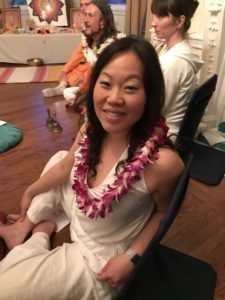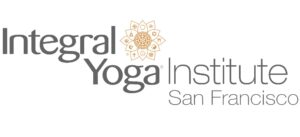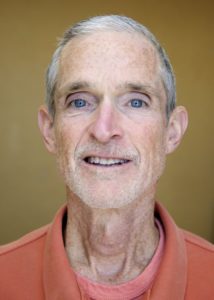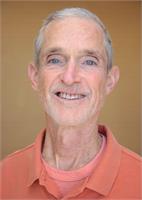How my self care led to serving others
by Pearl Bindu Bauer
I had just started a graduate program at Davis in September 2008, so not only was I stressed and tired from coursework and commuting, but I was without extra funds to spare on self care. A friend mentioned Integral Yoga Institute (IYI) because he knew I had been shopping around for a yoga studio that spoke to my soul; he also knew that IYI offered a work exchange program so I could volunteer and take free yoga classes in exchange. I lived only a few blocks away from the Institute, so I decided to take a class one Thursday morning, and more than 10 years later I still remember it so vividly. Saraswati beautifully led us through a Hatha 1 class, and I remember my heart singing after the 90 minutes was over. Deep relaxation and pranayama practice were all new to me, and I didn’t realize that yoga could be a deeply transformative experience. I was also surprised and impressed with how different this class was from the “mc-yoga” classes that other studios in the city were offering. It was the kind of class I was looking for, and I immediately spoke to the receptionist about the work exchange program. Within a week, I was working in the kitchen.
Every Thursday for two years, I took the 9:30am Level I/II class in the Temple and then at 11:00am, I went down to the kitchen and helped the kitchen mom prepare meals for the IYI community. In my classes, I learned how to use yoga postures and breath as a destressor, for example how to use the asana and pranayama practice to come into my body. In the kitchen, I learned how to cook meals that emphasized a sattvic diet, for example how to use asafoetida instead of garlic and onion and how to cook nutritious vegetarian foods made of nuts, seeds, whole grains, fruits and vegetables to help build our bodies and calm our minds. As the weeks and months progressed, I began to meet many wonderful people who became my friends and teachers, and I became acquainted with Swami Satchidananda’s insightful (and witty!) teachings – back in those days, we listened to cassette tapes of Satchidananda’s satsang while we ate the first half of our meal in silence. I found his teachings profoundly useful as I deepened my own spiritual practice, and I enjoyed incorporating his messages into my daily life.
Swami Satchidananda has said that the more you live for others, the more others live for you, and my experience serving at IYI has shown me the truth of these words. While my original motivation for working in the kitchen was to gain free yoga classes, I realized that the experience was so much more profound. Indeed, I deepened my asana practice, but in the process, I found a family who inspired me to be my best self. Eleven years later, I have gone through Basic, Yoga Therapy and Intermediate Teacher Trainings. I’ve also joined the silent retreats at Commonweal, and I teach Hatha 2 in Jyoti on Saturday mornings. Even though I now live in Half Moon Bay, I commute into the city to teach these classes because it’s important for me to remain connected to this wonderful community. Who knew that my decision to work in the IYI kitchen so many years ago would have become such an invaluable experience in my life? To this day, I am eternally grateful for all that I have learned and continue to learn.
 Pearl Bindu Bauer has been practicing yoga for 20 years, teaching for 8. The literal meaning of yoga is “union” and what she loves about yoga is how it helps her find alignment in her body/mind/spirit and physical/emotional connections. While meditating helps her stay clear, the asana practice on the mat helps her come into the body – the balance between the two is key for her daily practice. In her Hatha 2 classes, she often incorporates an intentional practice – for example, a gratitude or a vision-making practice. She finds that giving students focus as they are flowing through asanas is key in aligning the physical body with the spiritual experience, a true yogic union.
Pearl Bindu Bauer has been practicing yoga for 20 years, teaching for 8. The literal meaning of yoga is “union” and what she loves about yoga is how it helps her find alignment in her body/mind/spirit and physical/emotional connections. While meditating helps her stay clear, the asana practice on the mat helps her come into the body – the balance between the two is key for her daily practice. In her Hatha 2 classes, she often incorporates an intentional practice – for example, a gratitude or a vision-making practice. She finds that giving students focus as they are flowing through asanas is key in aligning the physical body with the spiritual experience, a true yogic union.







